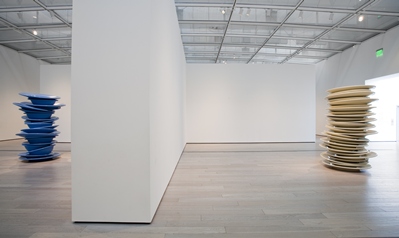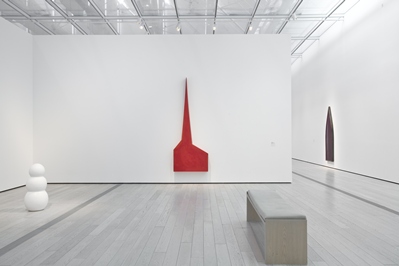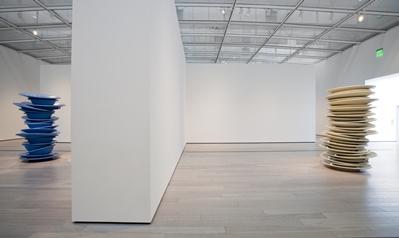Maybe you know this riddle someone recently told me: You leave home, you make three left turns, and you arrive back facing two masked men. What’s going on? To some extent Robert Therrien’s art engenders, if considered as a whole, a puzzle that is both profound and quite silly. These visual puns are the foundation of pop art’s reverence of modern life. But for Therrien, these sculptural entities seem to be flying in opposite directions and for entirely different purposes. Maybe it is churlish of me to expect something else. Long guard duty can leave you with questions that mere looking can’t quite resolve. You step onto the third floor of the Broad Contemporary Art Museum, and as you enter the gallery to the left, you encounter a large, haphazard stack of giant ivory plates. To your right is a fairly small painting of a blue oval. Thus, the journey begins between them. As you continue on, you realize there’s another stack, only this one is blue. Walking around these stacks gives you a dizzy sensation—which tells you something more about the art. It’s funny.

Installation view of "Robert Therrien: Selections from the Broad Collection and the Los Angeles County Museum of Art." Artworks © Robert Therrien/Artists Rights Society (ARS), New York
In the next room you find a beautifully upholstered black leather bed rising up, twisting toward the ceiling. It’s almost musical and all that is missing is a top hat, but of course, there it is—a straw boater in wood standing on its brim. It’s theater! Somewhere between commentary and sculptural invention, all the pieces placate this divide of the precarious and the pure.

Robert Therrien, Untitled (black beds), 1998, gift of Gail and Tony Ganz in memory of Robert Shapazian, © Robert Therrien/Artists Rights Society (ARS), New York
So, to me, Therrien’s art is about structure and reception more than form. Admittedly, at times this is a cultural joke freighted as it were as pop art and minimalism—where Disney meets Kandinsky, where Mies van der Rohe and Sealy Posturepedic meet surrealism and the film Inception. Robert Therrien manages to mine an absurdist dreamscape that lodges somewhere between Lewis Carroll and late-twentieth-century art’s fascination with Koons-ish zany domesticity and monumentality. It’s play that goes beyond playfulness. It’s a quirky world of everyday hardcore encounters—pots and pans, dishes, stoves, and tables with their intrinsic lived-in messiness and odd character construction that are somehow passionately pushed to another degree of scale and heft that bestows on them a torturous reality of restless, unstable energy. Contrapuntally, he gives us these extraordinary reductive forms in which the ghost of some previous utilitarian item merely existed. Here, we lose that topsy-turvy, disconcerting abstraction for perfect shapes, a geometrical universe in which artists in general seem to be perpetually entangled—that perfect world.

Installation view of "Robert Therrien: Selections from the Broad Collection and the Los Angeles County Museum of Art." Artworks © Robert Therrien/Artists Rights Society (ARS), New York
I recently had the pleasure of viewing a large selection of Therrien’s works at the Gagosian Gallery, including beards in all forms—from normal-sized plastic beards to gigantic wire “hairs” in a wooden cage. I could not help but think of Jack and the Bean Stalk, pathetically. His recurring cartoon images keep one off balance. Thus, Robert Therrien creates a disquieting world in which you never quite laugh and that, for me, echoes modernism’s split personality by which any very real object in the Duchampian universal parlance of art—the human stuff—can simply be labeled and made ironically perverse, vaguely macabre, or weirdly humorous with sexual or sexless overtones and a messy undertow of violence and unease. On the other hand, the long shadow of Kazimir Malevich is cast where Therrien finds himself in the cool embrace of the same clean, frictionless forms as one of his heroes, Constantin Brancusi, and his Bird in Space. Just maybe, Robert Therrien was trying to fit them together. But more likely than not, he was prepared to live with the dichotomy of his own making—the puzzle’s sweet chaos in which nothing is really settled. Oh! And, of course, the answer is you’ve arrived at home plate. Hylan Booker



